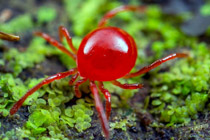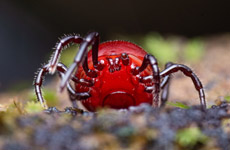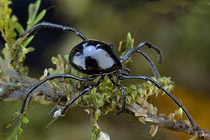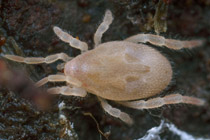 |
Slovak Arachnological Society |
|
Holothyrida |
|
|
Opilioacarida • Holothyrida • Ixodida • Mesostigmata • Trombidiformes • Sarcoptiformes |
|
 |
Slovak Arachnological Society |
|
Holothyrida |
|
|
Opilioacarida • Holothyrida • Ixodida • Mesostigmata • Trombidiformes • Sarcoptiformes |
|
According Walter (2006)
adults are orange, red, reddish brown to almost black, beetle-like with
fully sclerotized dome-shaped holodorsal shield with short, broad
peritremes above legs III and with or without one pair of lateral
ocelli. The holoventral shield encompasses a posterior pair of anal
valves each with ≥ 2 setae, and in the intercoxal region, a pair of
transverse, setose genital valves in the male and usually 4 setose
genital shields in the female. Chelicerae 3-segmented; palps 5-segmented
[see original source].
Holothyrids comprises 3 families, 15 genera, and 31 species (Beaulieu et al. 2011,
Beron 2018, Schmidt 2010).
 |
 |
 |
 |
Holothyrus, Mauritius (© Nick Porch) |
Neothyrus, Colombia (© damienbr) |
Thonius, Papua [© Piotr Naskręcki] |
Allothyrus TN, Australia (© Nick Porch) |
The geographical distribution of the Holothyrida order comprises several places: Costa Rica, Panama, Dominican Republic, Trinidad and Jamaica (Central America); Venezuela, Colombia, Peru, French Guiana and Brazil (South America); Seychelles, Mauritius and Rodrigues Islands (Africa); Sri Lanka, Philippines and Luzon Island (Asia); New Guinea, Louisiade Archipelago, New Caledonia, Australia, New Zealand and Lord Howe Island (Oceania) (Johnston 1982, Bernardi et al. 2011).
Many of the holothyrids are endemic genera, and not because they have not been looked for elsewhere, but it seems that on their islands they might be really endemic (Beron 2018). The family Neothyridae is American with five described species from Dominican Republic (Caribothyrus), French Guyana, Brazil (Diplothyrus), Peru and Venezuela (Neothyrus). From Australia have been described family Allothyridae with two genera (Australothyrus and Allothyrus). The last one has been recorded also from New Zealand (Allothyrus australasiae), the same species described from Australia, but such important finding has not been confirmed since. What concerns the Old World is that there live the remaining 23 species of 10 genera. The heavy weight of the whole order seems to be in New Guinea with 11 species of the genera Hammenius, Leiothyrus, and Thonius. They all belong to the family Holothyridae, spread from Mauritius to New Caledonia. Endemic genus and species for Sri Lanka is Indothyrus greeni. New Caledonia and Lord Howe Island, being between Australia and New Zealand, share genus Lindothyrus. Another monotypic genus Haplothyrus is endemic to New Caledonia. Particularly interesting is the presence of Holothyridae on the islands close to Africa, but not in Africa itself or Madagascar. On the Seychelles live at least four species of three endemic genera: Dicrognathus, Michaelothyrus, and Sternothyrus. Finally, Mauritius remains with two species of the genus Holothyrus (plus one uncertain species from Rodrigues Island). The distribution of the holothyrids over so many islands far from each other and their (apparent) absence from places like Africa, Madagascar, or India remain among the riddles of zoogeography (Beron 2018).